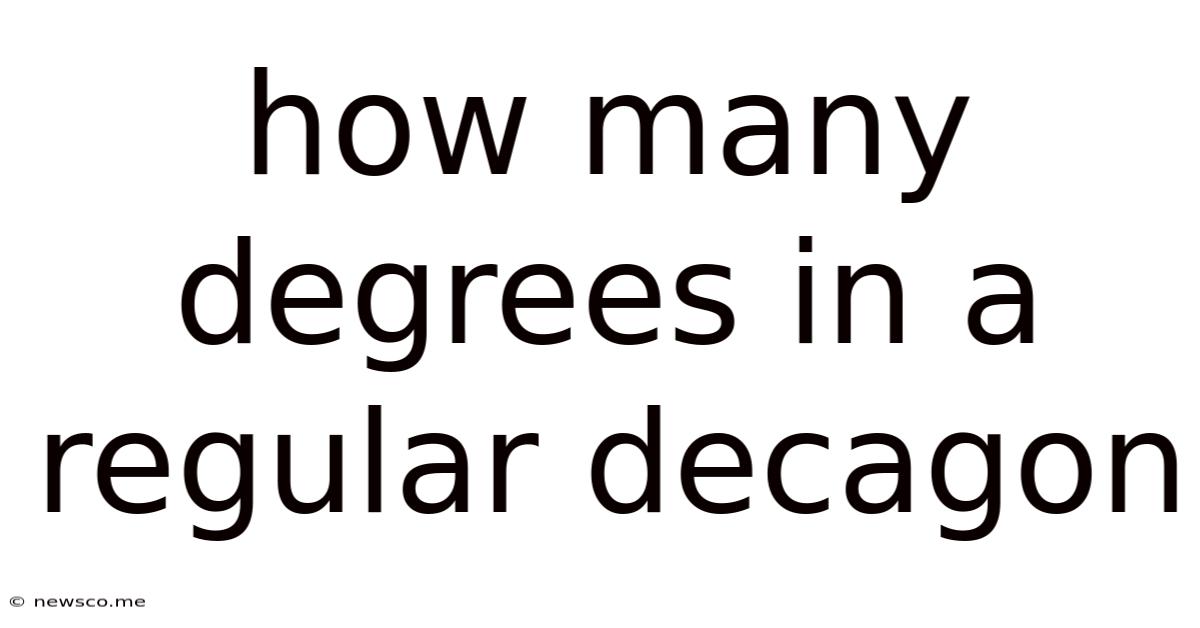How Many Degrees In A Regular Decagon
News Co
May 08, 2025 · 5 min read

Table of Contents
How Many Degrees in a Regular Decagon? A Comprehensive Guide
The question, "How many degrees in a regular decagon?" might seem simple at first glance. However, understanding the answer requires a grasp of fundamental geometric principles. This comprehensive guide will not only answer that question definitively but also explore the underlying concepts, providing you with a robust understanding of polygons and their properties. We will delve into the calculations, explore variations, and even touch upon related geometric concepts. Let's begin our journey into the fascinating world of decagons.
Understanding Polygons: A Quick Recap
Before we dive into the specifics of decagons, let's establish a foundational understanding of polygons. A polygon is a closed two-dimensional figure formed by connecting straight line segments. These segments are called sides, and the points where the sides meet are called vertices. Polygons are classified based on the number of sides they possess:
- Triangle: 3 sides
- Quadrilateral: 4 sides
- Pentagon: 5 sides
- Hexagon: 6 sides
- Heptagon (or Septagon): 7 sides
- Octagon: 8 sides
- Nonagon: 9 sides
- Decagon: 10 sides
- Dodecagon: 12 sides
- And so on...
A regular polygon is a polygon where all sides are equal in length, and all interior angles are equal in measure. This is crucial for our decagon calculation. Irregular polygons, on the other hand, have sides and angles of varying lengths and measures.
Calculating the Interior Angles of a Regular Decagon
A regular decagon, as its name suggests, has ten equal sides and ten equal angles. To determine the total number of degrees in a regular decagon, we can use a formula derived from the properties of polygons. This formula is based on the concept that a polygon can be divided into triangles.
The Formula:
The sum of the interior angles of any polygon with 'n' sides can be calculated using the formula:
(n - 2) * 180°
Where 'n' is the number of sides.
Applying the Formula to a Decagon:
For a decagon, n = 10. Substituting this into the formula, we get:
(10 - 2) * 180° = 8 * 180° = 1440°
Therefore, the sum of the interior angles of a regular decagon is 1440°.
Finding the Measure of Each Interior Angle
Since a regular decagon has ten equal angles, to find the measure of each individual interior angle, we simply divide the total sum of interior angles by the number of angles (which is equal to the number of sides):
1440° / 10 = 144°
Therefore, each interior angle of a regular decagon measures 144°.
Exterior Angles of a Regular Decagon
The exterior angles of a polygon are the angles formed by extending one side of the polygon at each vertex. For a regular polygon, the exterior angles are also equal. The sum of the exterior angles of any polygon, regardless of the number of sides, always equals 360°.
Therefore, for a regular decagon:
360° / 10 = 36°
Each exterior angle of a regular decagon measures 36°.
Visualizing the Decagon and its Angles
Imagine a regular decagon. You can divide it into eight triangles by drawing lines from one vertex to each of the other non-adjacent vertices. Each triangle has an interior angle sum of 180°, and since there are eight triangles, the total interior angle sum is 8 * 180° = 1440°. This visually reinforces the formula we used earlier.
Applications of Decagon Geometry
Understanding decagons and their properties isn't just an academic exercise. Decagons appear in various applications, including:
- Architecture: Certain architectural designs incorporate decagonal shapes for aesthetic or structural reasons.
- Art and Design: Decagons are frequently found in artistic creations, from geometric patterns to the design of various objects.
- Nature: While less common than other polygons, decagonal structures can occasionally be observed in natural formations.
- Engineering: Certain engineering designs may utilize decagonal shapes for specific functionalities.
Beyond Regular Decagons: Irregular Decagons
It's crucial to remember that the calculations above apply specifically to regular decagons. If the decagon is irregular (meaning its sides and angles are not all equal), the sum of its interior angles will still be 1440°, but individual angle measurements will vary. Calculating the individual angles in an irregular decagon requires knowing the measures of several other angles or sides using trigonometric techniques and geometry theorems.
Related Geometric Concepts
Understanding decagons often leads to exploring related concepts within geometry, such as:
- Circles and Inscribed Polygons: A regular decagon can be inscribed within a circle, meaning all its vertices lie on the circumference of the circle.
- Tessellations: While a regular decagon cannot tessellate (completely cover a surface without gaps or overlaps), exploring different tessellations with various polygons is a rich area of geometric study.
- Symmetry: Regular decagons exhibit rotational and reflective symmetry, making them fascinating subjects for symmetry analysis.
Conclusion: Mastering Decagon Geometry
This comprehensive guide provides a thorough understanding of how to calculate the degrees in a regular decagon. We started with fundamental polygon definitions, moved on to the formula for calculating the sum of interior angles, and then determined the measure of each individual interior angle and exterior angle. We also highlighted the importance of distinguishing between regular and irregular decagons and briefly explored the applications and related geometric concepts. By understanding these principles, you’ve expanded your knowledge of geometry and are equipped to tackle more complex geometric problems in the future. Remember, the key is to break down complex problems into manageable steps and apply the appropriate formulas and theorems. Happy exploring!
Latest Posts
Related Post
Thank you for visiting our website which covers about How Many Degrees In A Regular Decagon . We hope the information provided has been useful to you. Feel free to contact us if you have any questions or need further assistance. See you next time and don't miss to bookmark.